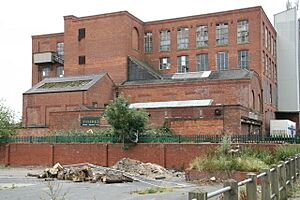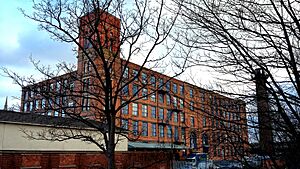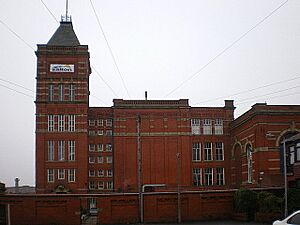List of mills in Failsworth facts for kids
Failsworth, a town in Greater Manchester, England, was once a very busy place for making textiles, especially cotton. A textile mill is like a big factory where raw materials, often cotton, are spun into yarn and then woven into fabric. These mills were super important during the Industrial Revolution because they changed how clothes and fabrics were made, moving from small home workshops to large factories.
Failsworth had many of these mills, and they provided jobs for lots of people. They helped the town grow and become an important part of the textile industry in the North West of England.
Contents
Famous Mills of Failsworth
Many mills operated in Failsworth, each with its own story. Here are some of the most well-known ones:
Albert Mill
The Albert Mill was built around 1850 on Albert Street. It was a large mill, and by 1915, it had an impressive 104,000 spindles, which are parts of machines that spin cotton into thread. The mill was expanded several times in the late 1800s and early 1900s. Sadly, a big fire in 1953 destroyed the original part of the mill. After its cotton days, it was used to make fireworks until 1997, and now it's a business center. 53°31′00″N 2°08′35″W / 53.5167727°N 2.1431433°W
Argyll Mill
Built in 1907 by Argyll Mill Ltd. on Holt Lane, this mill was also very large. By 1915, it had 117,000 spindles. It had a powerful 1600 horsepower engine, which is like a super strong motor! The mill was designed by F.W. Dixon & Son. In 1962, it stopped making textiles and was changed into a factory that made umbrellas, becoming known as Lawtex House. It was finally demolished in 1983. 53°30′25″N 2°08′46″W / 53.5069871°N 2.1459855°W
Chatsworth Mill
The Chatsworth Mill, also on Albert Street, was actually part of the bigger Albert Mill at first. It was built around 1861. This mill also met a fiery end, burning down in 1972. 53°30′56″N 2°08′33″W / 53.5156853°N 2.1426279°W
Cutler Hill Mill
This mill, sometimes called Hargreaves Mill, was built in 1887 on Ashton Road East by John Hargreaves. It was special because it made Turkish towels! By 1915, it had 90 looms, which are machines that weave thread into fabric. The mill was expanded a few times but eventually closed before the 1920s and became a chemical factory. It was demolished in the 1930s. 53°30′30″N 2°08′22″W / 53.5083081°N 2.1394235°W
Dob Lane End Mill
Built around 1860 by William Crossley on Morton Street, this mill was run by the Crossley family for about 30 years. In 1889, it had 370 looms. Later, in 1908, it was bought by a new company and renamed Dob Lane Mill Co. Today, it's still standing and is used as a sheet metal works. 53°30′18″N 2°10′32″W / 53.504891°N 2.175458°W
Failsworth Mill
Located on Ashton Road West, Failsworth Mill was built in 1897. In 1915, it had 66,000 spindles. It stopped making cotton in 1959 and was eventually torn down in 2014 to make space for new houses.
53°30′28″N 2°09′36″W / 53.50783°N 2.1601346°W
Firs Mill
Firs Mill, on Oldham Road, was one of the older mills, built in 1839. It had a very powerful engine, upgraded to 1600 horsepower in 1902! In 1915, it had over 92,000 spindles. It stopped cotton production in 1941 and was demolished in 1974. 53°30′37″N 2°09′25″W / 53.5103041°N 2.1569271°W
German / Louvain Mill
This mill on Louvain Street was built before 1854. It was first called German Mill, but during World War I, its name was changed to Louvain Mill because of anti-German feelings at the time. A fire badly damaged it in 1929, stopping production. After that, it had some unusual uses, including a wax company and even a boxing stadium, before it was demolished before World War II. 53°30′25″N 2°09′55″W / 53.5069104°N 2.1652804°W
Hope Mill
Built in 1874 on Ashton Road West by the Hope Cotton Spinning Co., this mill was quite large. By 1889, it had nearly 69,000 spindles. Its engine was upgraded over time to a powerful 1200 horsepower. The mill was expanded several times but closed in the 1930s and was demolished in 1936. 53°30′33″N 2°09′26″W / 53.5092037°N 2.157097°W
Ivy Mill
The Ivy Mill, built in 1883 on Crown Street by George Schofield, is a great example of how mills changed over time. It had several engines and many expansions. By 1915, it had over 76,000 spindles.
It stopped making cotton in 1934 and was then used by A. V. Roe & Co., a famous aircraft company, to make airplane parts during the war! Later, it became a warehouse for mail-order companies like Littlewoods. Today, it's known as the Ivy Business Centre, with offices inside. 53°30′43″N 2°09′26″W / 53.5118056°N 2.1573024°W
Lime Mill
Lime Mill, on Albert Street, was built in 1874. In 1915, it had 55,080 spindles and a 1150 horsepower engine. Like many mills, it stopped cotton production in 1934. Before it was demolished after 1998, it was used by a company called Dannimac. 53°31′04″N 2°08′32″W / 53.5178511°N 2.1422913°W
Marlborough Mills No.1 and No.2
These two mills, Marlborough No.1 on Mellor Street and Marlborough No.2 on Poplar Street, were built by Marlborough Mill Ltd. in 1905 and 1908 respectively. They were both very large, each having over 114,000 spindles and powerful 1700 horsepower engines by 1915. They were designed by P.S. Stott.
Both mills stopped making cotton in 1955. Marlborough No.1 is still standing today, but Marlborough No.2 was demolished in 2002. Interestingly, the Morrisons supermarket built in its place was designed to look like the old mill, even including a sign with the name "Marlborough." 53°30′18″N 2°10′03″W / 53.5049544°N 2.167505°W 53°30′15″N 2°10′11″W / 53.5040675°N 2.1696079°W
Morton Mill
Built in 1914 on Morton Street by E.S. Kearsley Ltd., Morton Mill was a smaller mill, used for "doubling" (twisting two or more threads together). In 1915, it had 21,000 spindles. It stopped cotton production in 1959 and was used by small businesses until a fire destroyed it on March 29, 2020. 53°30′18″N 2°10′33″W / 53.505125°N 2.1757195°W
Phoenix Mill
Originally known as New Road Mill, built before 1838 on Cheetham Street, it was rebuilt as Phoenix Mill in 1868. In the 1880s, it changed from a textile mill to an India Rubber Works, making rubber products. It stayed that way until 1989 and is now split into industrial units called Phoenix Industrial Estate. It's still standing today. 53°30′49″N 2°09′01″W / 53.5135721°N 2.1501665°W
Regent Mill
Regent Mill, on Oldham Road, was built in 1906. It was designed as a "ring-spinning" mill, a modern way of spinning cotton. It was a large, four-story building made with strong iron and steel beams to be fire-proof. It was powered by a huge 1800 horsepower steam engine!
Regent Mill is still standing today and is a listed building, meaning it's protected because of its historical importance. 53°30′31″N 2°09′37″W / 53.5087°N 2.1604°W
Ridgefield Mill
Built in 1875 on Ridgefield Street by Ridgefield Cotton Spinning Co., this mill was expanded several times. In 1915, it had almost 74,000 spindles. It had powerful engines, with the last one being 1300 horsepower. It stopped cotton production in 1935 and was demolished that same year, though an extension survived for a while as a workshop. 53°30′20″N 2°10′00″W / 53.505564°N 2.166651°W
Windsor / Rose Mill
Built in 1860 on Hollins Road (also known as Canal Street) by John Stott, this mill had a section called Rose Mill between 1872 and 1885. It was expanded in 1835 and again in 1940-41. From 1926 until recently, it was used by a company that rubber-proofed garments. It was demolished in 2016. 53°31′05″N 2°08′39″W / 53.5181219°N 2.1440751°W
Wrigley Head Mill
Samuel Johnson & Co. built Wrigley Head Mill on Wrigley Head Crescent in 1882. It had a 300 horsepower engine, later upgraded to 350 horsepower. The mill was expanded twice and by 1915, it had 42,000 mule spindles and 11,000 ring spindles. After it stopped making cotton in 1959, it was used by a builders' and plumbers' merchant before being demolished in 1988. 53°30′48″N 2°09′24″W / 53.5132061°N 2.15667281°W





